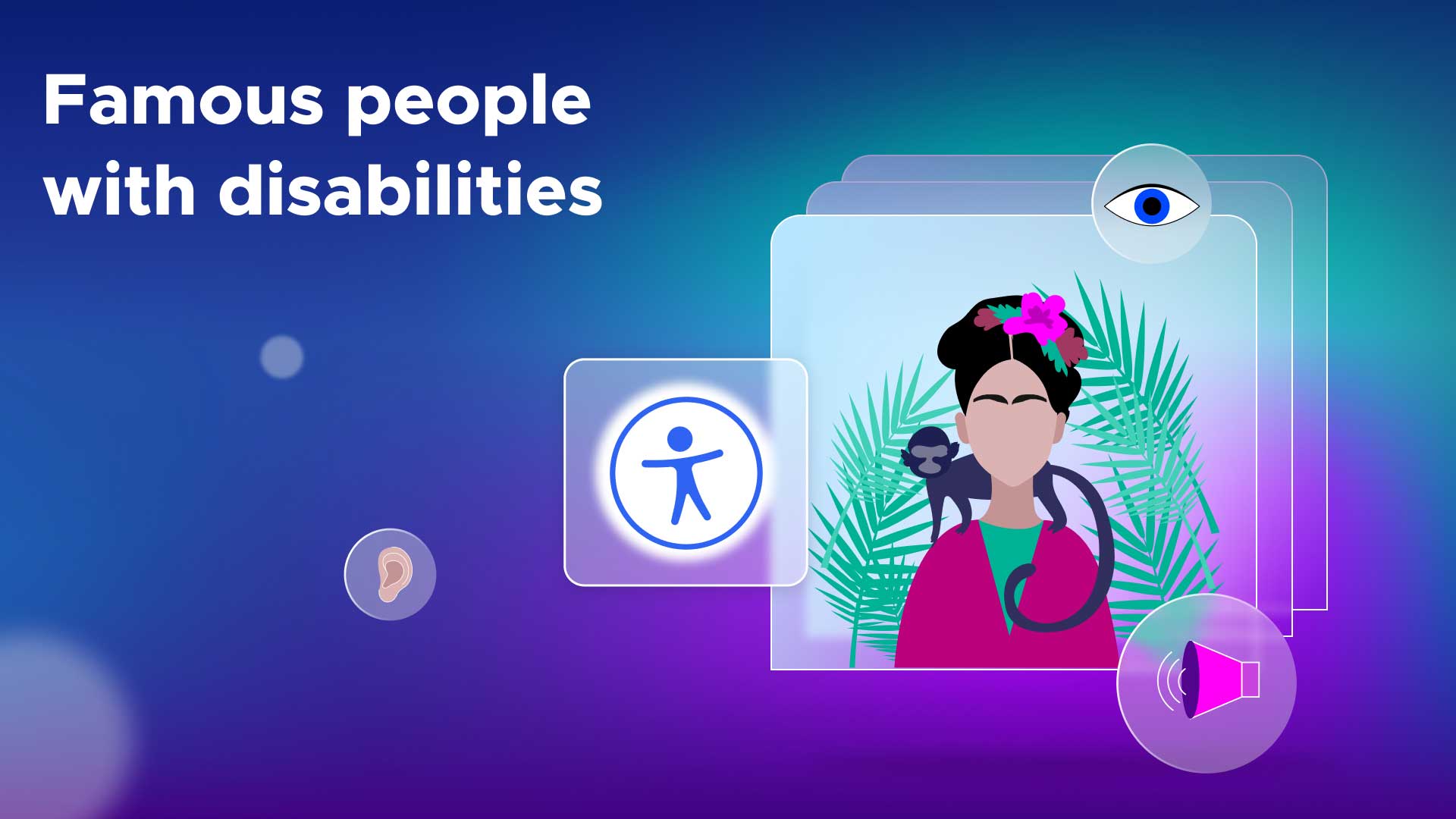What We Can Learn from Famous People With Disabilities

Have you ever been curious about how famous people with disabilities overcome their unique challenges?
Disabilities touch lives across all spectrums of society, affecting individuals ranging from renowned celebrities to influential icons. This article looks into the lives of some popular people with disabilities, their careers, viewpoints, and their significant contributions to diverse fields such as the arts, music, business, and history.
Join us as we explore the journeys of well-known individuals with disabilities, including a variety of celebrities, artists, and comedians. Through their stories and experiences, we’ll uncover how these individuals have confronted their challenges, offering valuable insights and serving as sources of inspiration for many.
5 Famous People With Disabilities: Icons of Influence
Of course, disability doesn’t diminish talent, self-belief or determination In fact, it often builds paths to achievement. The following list celebrates five famous individuals with disabilities who have made significant impacts in their fields:
1. Helen Keller (Author, Political Activist, and Lecturer)
Helen Keller, who was deaf and blind since childhood, emerged as a powerful advocate for individuals with disabilities. Guided by her teacher, Anne Sullivan, Keller mastered communication skills and went on to achieve a college education. Her dedication to activism and her work as an author significantly advanced the treatment and perception of people with disabilities. Keller’s life stands as a testament to overcoming obstacles and achieving great success.
2. Stephen Hawking (Theoretical Physicist, Cosmologist, and Author)
Diagnosed with ALS at 21, Stephen Hawking defied expectations by living over 50 years with the condition. A renowned Cambridge professor and director of the Center for Theoretical Cosmology, he’s famed for “A Brief History of Time” and his work on black holes and relativity. Despite his physical limitations, Hawking continued to teach and research, using a speech-generating device.
3. Sir Richard Branson (Business Owner and Entrepreneur)
A high school dropout at 15, dyslexic Richard Branson rose to become a billionaire business mogul. He founded Virgin Records, Virgin Atlantic, and Virgin Galactic, among others. Known for his adventurous spirit, Branson attributes his success to self-determination and tackling seemingly impossible challenges.
4. Ludwig van Beethoven (Musician)
Despite becoming almost completely deaf, Ludwig van Beethoven, one of history’s greatest composers, continued to compose, conduct, and perform. His late works, created during his deafness, are some of his most admired, proving his remarkable ability to overcome profound challenges and continue his musical innovation.
5. Whoopi Goldberg (Actress, Host and Comedian)
Goldberg is another well known person who has a disability. She has dyslexia, a learning disorder where she experiences difficulties with word recognition and by poor spelling and decoding abilities. Despite this challenge, Goldberg has had a highly successful career. She’s one of the few entertainers to have won an Emmy, Grammy, Oscar, and Tony Award, showcasing her diverse talents across multiple platforms.
5 Artists With Disabilities: Where Creativity Meets Resilience
In the world of art, adversity has often fueled creativity. The following five famous artists with disabilities, have transformed their challenges into expression, strength and inspiration:
1. Pablo Picasso (Painter, Artist)
Picasso has changed how the world sees art. His childhood struggles with dyslexia contributed to the art genre, Cubism. Critics and fans saw the artist’s rearranging of common elements as artistically visionary. But Picasso also revealed how his condition gave him a distinct perspective that changed the art world.
2. Frida Kahlo: (Painter, Artist)
Mexican painter Frida Kahlo, renowned for her vivid, symbolic self-portraits, lived with polio as a child and later survived a severe bus accident that left her with lifelong injuries. Her art often reflects her physical pain and struggles, making her a powerful figure in representing the lived experience of disability.
3. Vincent van Gogh: (Painter, Artist)
The legendary Dutch painter, Vincent van Gogh, battled mental illness throughout his life, which significantly influenced his art. His unique style and emotionally charged works, like “The Starry Night,” emerged from his struggles, making him a posthumous symbol of genius thriving amidst personal turmoil.
4. Chuck Close: (Painter, Photographer)
Chuck Close is known for his massive-scale portraits. He faced a spinal artery collapse in 1988, which left him paralyzed from the neck down. Close adapted his painting techniques to work with his disability, continuing to produce acclaimed art.
5. Stevie Wonder: (Musician)
A musical prodigy blind from infancy, Stevie Wonder is a celebrated American singer, songwriter, and multi-instrumentalist. His work spans various genres and includes hits like “Superstition” and “Isn’t She Lovely.” Wonder’s achievements in music are a testament to his extraordinary talent and ability to transcend his disability.
Can you name a famous person with a disability that is not on our list?
Famous individuals with disabilities and the digital world
Stella Young, comedian, journalist and activist said, “My disability exists not because I use a wheelchair, but because the broader environment isn’t accessible.”
Many individuals with disabilities have shared their experiences of feeling excluded from much of the world. Accessing various aspects of society isn’t a straightforward path. They’ve had to overcome significant challenges just to take part in everyday life and to enjoy the same opportunities that others might take for granted.
But it’s not just about physical spaces. These people also face hurdles in the digital realm. So, what exactly does this mean?
When we talk about digital accessibility, we’re referring to the design and creation of digital content, tools, and technologies that are usable by everyone, including people with a wide range of disabilities.
This means websites, mobile apps, and online documents should be designed so that they can be navigated and understood by users who may have visual, auditory, motor, or cognitive impairments.
For famous personalities with disabilities, just like for anyone else, the way digital content is presented can significantly impact their ability to interact with it. Take, for example, a renowned musician who has a visual impairment. They would rely on screen readers to access online content. If a website isn’t designed with accessibility in mind, they might miss out on vital information or opportunities.
The importance of digital accessibility extends beyond individual convenience. It’s about equal participation in the rapidly evolving digital landscape. In a world where so much of our lives are online – from education and employment to entertainment and social engagement – ensuring digital inclusivity is not just a nice-to-have; it’s a necessity.
By embracing digital accessibility, we’re not only complying with legal standards like the Americans with Disabilities Act (ADA) but also embracing a broader commitment to inclusivity. This commitment opens up a world of possibilities for all users, including those who are often overlooked. It’s about building a digital world where everyone, including the most influential figures with disabilities, has equal access to information, tools, and opportunities.
Popular people with disabilities champion digital accessibility
Just as many of the famous people we’ve mentioned have been advocating for equal rights, UserWay is advocating equal rights in the digital world.
UserWay is a leader in digital accessibility, committed to empowering the fundamental human right for inclusive digital experiences.
Our mission aligns with the advocacy efforts of famous figures who have championed equal rights, aiming to make the digital world inclusive and accessible to everyone, regardless of their abilities.
UserWay: Digital Accessibility for All
Disability is a part of the human experience that transcends all boundaries. It doesn’t discriminate – it can touch anyone’s life, whether you’re a celebrated figure or an everyday individual.
At UserWay, we’re deeply aware of this reality and are committed to bridging the digital divide. Our AI-driven technology solutions are designed to elevate web accessibility, making online spaces more inclusive. We strive not just for ADA compliance, but to create a digital world that is truly accessible to everyone, regardless of their abilities.
Let’s work together to make the digital world a welcoming space for everyone. Let’s place inclusivity at the core of our digital strategies and designs.
FAQS
What is digital accessibility, and why is it important?
Digital accessibility is about crafting digital content and tools to be usable by everyone, including those with disabilities, fostering inclusivity and meeting legal standards like the ADA.
How can digital accessibility benefit people with disabilities?
Digital accessibility empowers everyone to access online content. With digital accessibility, famous people with disabilities can also easily engage with their audience, and participate in digital platforms, leveling the playing field for communication and interaction.
Are there any famous advocates for digital accessibility?
Yes, many famous individuals, including Stevie Wonder and Helen Keller, have advocated for digital accessibility. They recognize its significance in ensuring that all individuals, regardless of their abilities, can access and benefit from digital resources and information.




Share